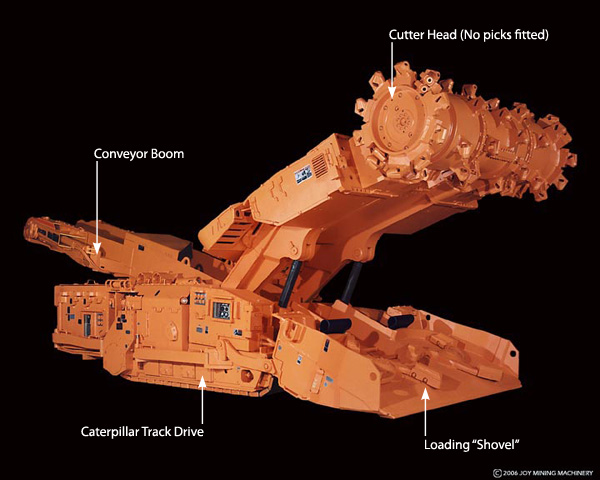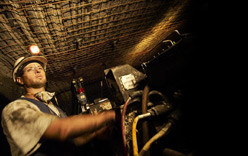Continuous miners
Though there are many variations in design, continuous
miners mostly consist of five main elements:
-
A central body to carry all other
components mounted on some type of drive mechanism to provide mobility (most
commonly caterpillar tracks).
-
A "cutting head" usually rotating drum(s) and/or chains
with cutting picks attached
-
A loading mechanism to pick up cut coal and
deliver it into the central part of the machine
-
A conveying system, usually a chain
conveyor running in a steel trough from front to rear of the miner
-
A rear jib section capable of a degree of
vertical and horizontal movement to enable the coal to be delivered into a
transport or loaded at a desired point.

Some continuous miners (at one time almost all) could
not cut the full roadway width in one pass but had to be moved backwards and
forwards and from side to side in order to cut the full profile. This often
results in a very rough rib line (bad for stability and ventilation flow) and
delays the ability to install support into/under freshly exposed roof for a
period. The advantages of the ability to cut the full profile in one pass was
recognized early, but was not easy to achieve. Cutting forward in a straight
line could be readily accommodated, but it is necessary to be able to turn
corners, mostly at right angles, and to be able to retreat the cutting machine
from one roadway to relocate at frequent intervals. These factors have proved
major stumbling blocks to many developments. In machines which covered the full
face, steering in the vertical plane could also be a major difficulty.
The term "continuous" as applied to development
machines has been one of the biggest misnomers used for mining equipment
because, on development, they are usually anything but continuously cutting.
The main delays mostly occur while roof support is installed and often waiting
for shuttle cars to return from their discharge point for reloading. When
actually cutting, cutting rates are usually more than adequate, but when
averaged over a shift cutting rates are often poor and this is one of the
reasons many mines have difficulty developing at rates adequate to prevent long
delays on longwall production. As a result, development is an area receiving
major attention in recent times. Many of the difficulties have been overcome
and most modern continuous miners are "full face" machines. They also have roof
bolting equipment mounted on the miner in locations allowing roof bolts to be
installed reasonably close to the face.
The "ideal" continuous miner would:
-
Be able to cut the full face in one pass
-
Be easily moveable between locations
without dismantling parts
-
Be able to excavate right angle turns with
a minimum radius
-
Have roof and rib bolters fixed to the
machine in a location where each row of the designed support pattern can be
installed without moving the miner and be installed close to the cut face if
necessary
-
Have adequate space alongside to allow good
ventilation of the face area for efficient removal of gas and dust.
-
Allow strata supports to be safely
installed while coal cutting continues
Many of these ideals have been achieved to varying
degrees of satisfaction (the last being an area of minimal success), but
matching development rates with longwall retreat rates is still a major problem
for many mines. Increasing numbers of development units to attain longwall
continuity is expensive and provides extra strain on all other service
functions (personnel, ventilation, materials handling, power and water
supplies, gas drainage, etc, etc) and is not usually a satisfactory solution.

